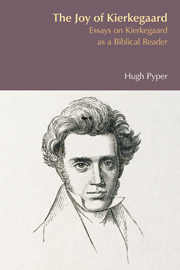Book contents
- Frontmatter
- Contents
- Preface
- Acknowledgments
- Abbreviations
- 1 The Joy of Kierkegaard
- 2 Kierkegaard's Canon: The Constitution of the Bible and of the Authorship in Concluding Unscientific Postscript
- 3 The Apostle, the Genius and the Monkey: Reflections on Kierkegaard's ‘The Mirror of the Word’
- 4 Your Wish Is My Command: The Peril and Promise of the Bible as ‘Letter from the Beloved’
- 5 The Lesson of Eternity: The Figure of the Teacher in Kierkegaard's Philosophical Fragments
- 6 Cities of the Dead: The Relation of Person and Polis in Kierkegaard's Works of Love
- 7 Adam's Angest: The Language of Myth and the Myth of Language
- 8 Beyond a Joke: Kierkegaard's Concluding Unscientific Postscript as a Comic Book
- 9 ‘Sarah Is the Hero’: Kierkegaard's Reading of Tobit in Fear and Trembling
- 10 How Edifying Is Upbuilding? Paul and Kierkegaard in Dialogue
- 11 Forgiving the Unforgivable: Kierkegaard, Derrida and the Scandal of Forgiveness
- Bibliography
- Index of Biblical References
- Index of Authors
2 - Kierkegaard's Canon: The Constitution of the Bible and of the Authorship in Concluding Unscientific Postscript
- Frontmatter
- Contents
- Preface
- Acknowledgments
- Abbreviations
- 1 The Joy of Kierkegaard
- 2 Kierkegaard's Canon: The Constitution of the Bible and of the Authorship in Concluding Unscientific Postscript
- 3 The Apostle, the Genius and the Monkey: Reflections on Kierkegaard's ‘The Mirror of the Word’
- 4 Your Wish Is My Command: The Peril and Promise of the Bible as ‘Letter from the Beloved’
- 5 The Lesson of Eternity: The Figure of the Teacher in Kierkegaard's Philosophical Fragments
- 6 Cities of the Dead: The Relation of Person and Polis in Kierkegaard's Works of Love
- 7 Adam's Angest: The Language of Myth and the Myth of Language
- 8 Beyond a Joke: Kierkegaard's Concluding Unscientific Postscript as a Comic Book
- 9 ‘Sarah Is the Hero’: Kierkegaard's Reading of Tobit in Fear and Trembling
- 10 How Edifying Is Upbuilding? Paul and Kierkegaard in Dialogue
- 11 Forgiving the Unforgivable: Kierkegaard, Derrida and the Scandal of Forgiveness
- Bibliography
- Index of Biblical References
- Index of Authors
Summary
Questions of canonicity form an inclusio for Concluding Unscientific Postscript. The book begins with Climacus' discussion of the irrelevance of historical and theological debates about the canon of the Scriptures to Christian faith and ends with the ‘First and Last Explanation’, signed by Kierkegaard himself, which discusses the canon of his own authorship. This circling back to the initial question is fitting in view of the fact that these questions themselves lead to a series of circularities in our reading of Postscript. Furthermore, in the body of Postscript there is another more elaborate discussion of the constitution of the canon of the authorship in ‘A Glance at a Contemporary Effort in Danish Literature’, where Climacus comments on the interrelationships between not one but three ‘canons’: the set of pseudonymous works, behind which Climacus implies there is a single author; Magister Kierkegaard's Upbuilding Discourses; and Climacus' own Philosophical Fragments, with the present text Postscript assigned its canonical role as a sequel. These discussions have their own problems of canonical status: what is the significance of the fact that ‘A Glance…’ is described as an appendix, and that the ‘Explanation’ is on unnumbered pages, following on Climacus' revocation of Postscript? Are these texts part of Postscript or not?
The question of what constitutes a canon and how awareness of a text's place in a canon shapes our reading of it can be applied to our reading of Postscript itself.
- Type
- Chapter
- Information
- The Joy of KierkegaardEssays on Kierkegaard as a Biblical Reader, pp. 14 - 31Publisher: Acumen PublishingPrint publication year: 2012



